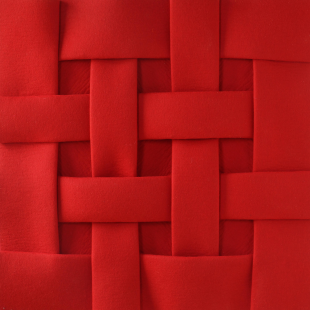Klaus Honnef
In a text about Peter Weber's works, Eugen Gomringer mentions that his method of folding is a holistic method that changes its material but does not interfere with its substance, neither partially destroys nor cuts. "There are surface enlargements, pseudo-forms, pseudo-networks that are to be addressed as individual shapes and yet are only folds." (Gomringer). The signature of modernism, on the other hand, is the cut, the montage.
The method of folding, which is a method of constant integration without suppressing the edges that appear as interfaces, points both forward and backward, behind and in front of modernity. For this reason it is not at all wrong to speak of a renaissance of the classical spirit in Weber's work and the works of artists with a comparable attitude. Irrespective of the external difference, the structural similarities are striking.
Marina von Assel
This is how the folds only work because they are not actually dealing with surfaces, but with special bodies that are large in the first two dimensions but very small in the third dimension. They appear as embodied surfaces. These 'surface bodies' can only be folded in a few materials. However, the discrepancy between the space and the surface is always noticeable and is addressed in the painterly aspect of the shadow-casting fold lines as well as in the almost transparent nature of HDPE.
Folding of a surface becomes possible at the moment when 'surface' and 'space' are not only understood as contrasting abstract definitions of an imagined world, but are transferred out of the world of ideas and thus into a real existence. In this way they themselves become elements of the world of things. Then, in the transformation of the surface into a spatial form, the material unfolds to convey the idea. In this paradoxical world of surface and space, the abstract laws of geometry become reality that can be experienced in concrete terms. Sense and sensuality go hand in hand.
Klaus Peter Denker
In all of this, however, one should not forget that, in my view, something very elementary is important to Peter Weber: trying things out, if not to say the playful moment of appropriation and order that is always associated with it.
The artist as homo ludens – the audience as partner. Seen in this way, Peter Weber's works are playfully created play objects of the mind and aesthetic perception against the background of mathematical principles, sensual metaphors of regularity.
Wita Noack
However, Peter Weber's interest is not focused on the individual, but on a supra-individual, objective design. The artist sets himself apart from the arbitrariness of individual creativity, which is only subject to subjective taste. It offers us, the viewers, an aesthetic model for understanding the world, for example for perceiving space.
Our vision is sensitized by perceiving the differences in the folded edges. Hints of perspective show that seeing is also a spatial, even physical, experience. The works of art invented by Weber give us the opportunity to re-understand our "being-in-the-world". You are a gift, a boon to us.
Eugene Gomringer
folding is an activity that we see as opposed to dividing and dissecting. Whoever folds always assumes a whole and leaves this whole as such. if you fold, new forms are created underhand. folding is an old practical way of changing things without destroying them.
on the contrary, to give them a high aesthetic gain. peter weber has the right material for the right method or the right material for the right method. folding is an independent design component. you can only fold what can be folded.
Bettina Textor
Parallels to the objects in the exhibition are obvious: the original form, eg a square, is transformed beyond recognition by folding and twisting, but nevertheless remains there as an imaginary form element. It is the task of the viewer to comprehend this variation:
Apparent irregularities in some folds turn out to be the result of a stringent development process.
Solidity is also evident in the handling of the material: Weber works all the folds from one piece and deliberately avoids any material cuts and insertions. As a result, each object forms a unit despite the "diversity".
